The NVIDIA GeForce GTX 780 Ti Review
by Ryan Smith on November 7, 2013 9:01 AM ESTPower, Temperature, & Noise
As always, last but not least is our look at power, temperature, and noise. Next to price and performance of course, these are some of the most important aspects of a GPU, due in large part to the impact of noise. All things considered, a loud card is undesirable unless there’s a sufficiently good reason – or sufficiently good performance – to ignore the noise.
| GeForce GTX 780 Series Voltages | ||||
| GTX 780 Ti Boost Voltage | GTX 780 Boost Voltage | GTX 780 Ti Base Voltage | ||
| 1.187v | 1.1625v | 1.012v | ||
Taking a quick look at voltages, we find that our GTX 780 Ti operates at a slightly higher voltage at its maximum boost bin than the original GTX 780 did. The difference is minor, but the additional voltage may be necessary to hit the slightly higher clockspeeds GTX 780 Ti operates at relative to GTX Titan and GTX 780.
| GeForce GTX 780 Ti Average Clockspeeds | |||
| Max Boost Clock | 1020MHz | ||
| Metro: LL |
1000MHz
|
||
| CoH2 |
997MHz
|
||
| Bioshock |
954MHz
|
||
| Battlefield 3 |
980MHz
|
||
| Crysis 3 |
980MHz
|
||
| Crysis: Warhead |
1000MHz
|
||
| TW: Rome 2 |
950MHz
|
||
| Hitman |
993MHz
|
||
| GRID 2 |
967MHz
|
||
| Furmark |
823MHz
|
||
Moving on to clockspeeds, we find that the GTX 780 Ti does very well when it comes to boosting. With a maximum boost clock of 1020MHz, we have 2 benchmarks averaging 1000MHz, and another 4 averaging 980MHz or better.
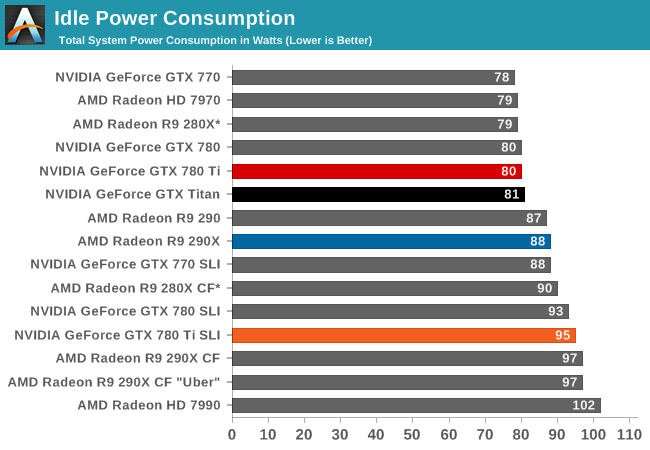
With all of our GK110 cards sharing a common design, at idle there’s very little to differentiate them. Other than GTX Titan’s extra 3GB of VRAM, we’re essentially looking at identical cards when idling.
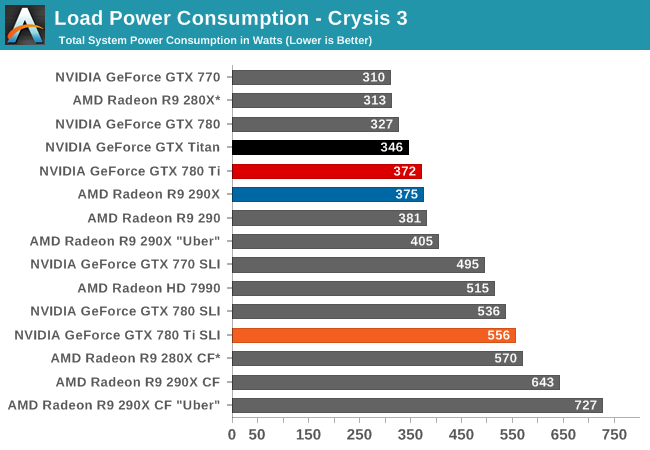
Moving on to load power, we can see the power/heat ramifications of the slight clockspeed increase coupled with the activation of the 15th SMX. Even with the further optimizations NVIDIA has put into the new revision of GK110, power consumption has gone up in accordance with the higher performance of the card, just as we’d expect. Since NVIDIA doesn’t notably alter their power efficiency here, that increased performance has to come at the cost of increased power consumption. Though in this benchmark it’s worth pointing out that we’re measuring from the wall and that GTX 780 Ti outperforms GTX Titan by 8%, so some of that 29W power difference will come from the higher CPU load caused by the increased framerates.
As for the GTX 780 Ti SLI, here we see power level off at 556W, 20W more than the GTX 780 SLI. Some (if not most) of that is going to be explained by the increased CPU power consumption from the GTX 780 Ti SLI’s higher framerates. Coupled with that is the fact that in SLI setups these cards get hotter, and hence have to downclock a bit more to maintain equilibrium, which helps to offset the increased power requirements of GTX 780 Ti and keep the SLI results so close to the GTX 780 SLI results.
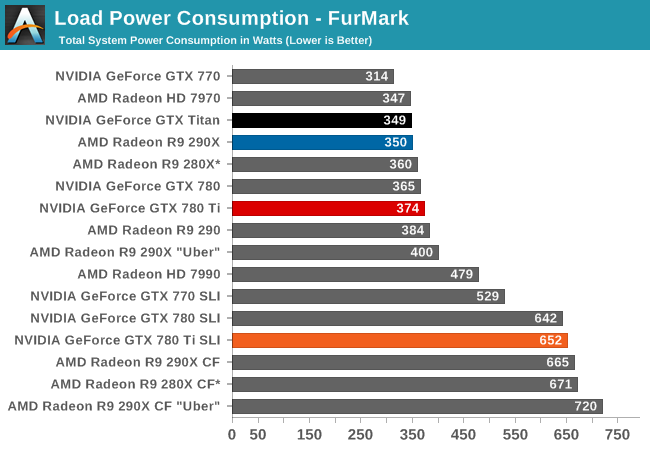
Switching over to FurMark, we find that power consumption is also up, but only slightly. With GPU Boost 2.0 clamping down on power consumption all of our GK110 cards should be clamped at 250W here, and with a difference between GTX 780 and GTX 780 Ti of under 10W, that’s exactly what appears to be happening here.
On a side note, it’s interesting to note here that under FurMark we’re seeing the GTX 780 Ti draw more power than the Radeon R9 290X. Despite the fact that the 290X has a higher rated TDP, in the card’s default quiet mode the card can’t actually dissipate as much heat (and thereby consume as much power) as the GTX 780 Ti can.
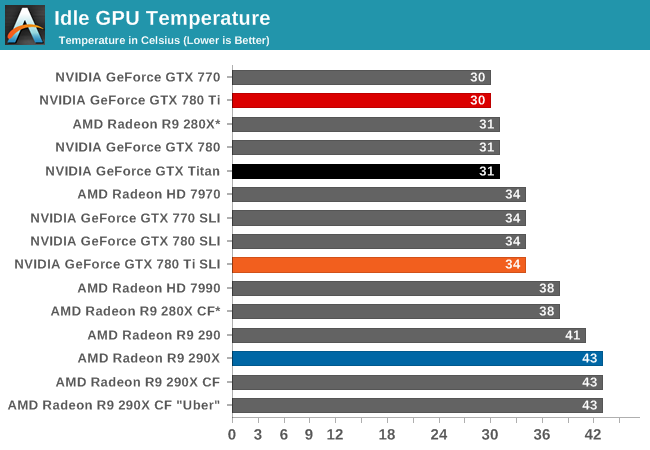
For idle temperatures we’re once again looking at cards that are for all intents and purposes identical. At 30C the GTX 780 Ti easily stays nice and cool.
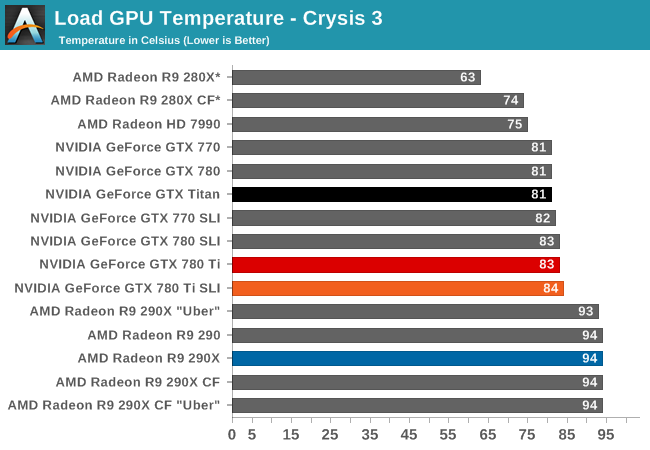
As we mentioned in our look at the GTX 780 Ti hardware, NVIDIA has increased their default temperature throttle point from 80C on the GTX Titan/780 to 83C on the GTX 780 Ti. The end result is that in all of our temperature limited tests the GTX 780 Ti will peak at 83C-84C, whereas the older GK110 cards will peak at 80C-81C.

FurMark reiterates what we saw with Crysis 3. The temps are up a bit across the board, while the GK110 cards are holding near their throttle points. The SLI setups meanwhile approach the upper-80s at 88C, reflecting the fact that even with blowers, there’s some impact on neighboring cards in high load situations.
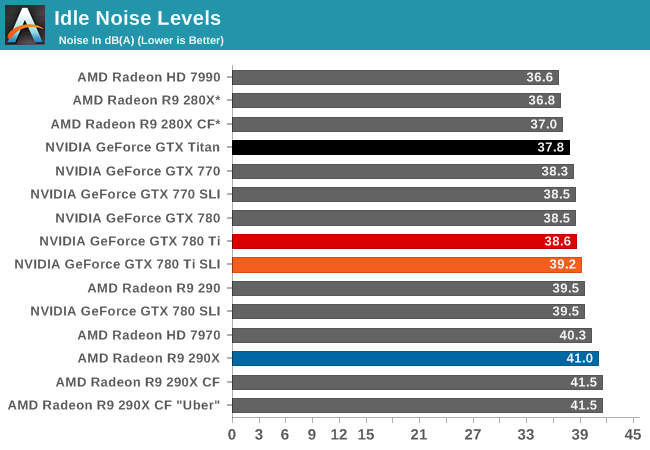
Our last idle scenario, we once again see all of our GK110 cards performing similarly, with idle noise levels in the 38dB-39dB range.
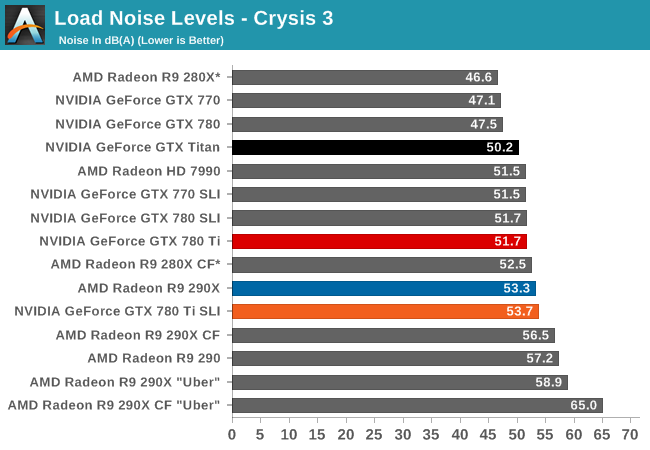
Moving on to our gaming load noise results, we can see the full repercussions of the GTX 780 Ti’s higher average power consumption coupled with the card’s higher temperature throttle point. Moving the throttle point along the same curve has the end result of moving higher the equilibrium point and thereby the card’s operating noise levels. As the fastest single-GPU card on this card, the GTX 780 Ti is still doing very well for itself and for a blower based design at 51.7dB, though at 1.5dB louder than GTX Titan and 4.2dB louder than GTX 780 the noise tradeoff for the card’s higher performance is very clear. Meanwhile the fact that it’s tied with the GTX 780 SLI comes with its own bit of irony.
Speaking of the GTX 780 SLI, we can see the noise impact of SLI configurations too. The GTX 780 Ti SLI levels out at 53.7dB, 2dB louder than our single-card configuration and 2dB louder than the GTX 780 SLI. At this point it’s just a bit louder than the 290X and quieter than a number of other 290 series setups.
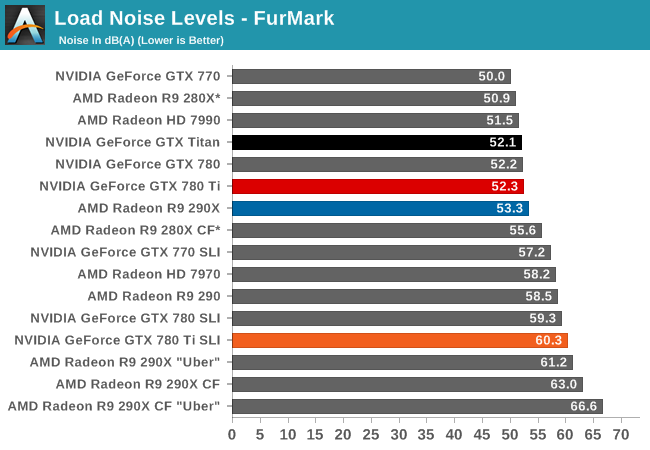
Finally with load noise levels under FurMark we can see where our various cards will peak at for noise levels. The GTX 780 Ti creeps up to 52.3dB, essentially tying with the GTX 780 and GTX Titan. Otherwise it comes in just behind the 290X, and the start of the pack for our multi-GPU setups.
As for the GTX 780 Ti SLI, like our single-card comparison points its up slightly as compared to the GTX 780 SLI.
Overall, our look at power, temperatures, and noise has been a rather straightforward validation of our earlier suspicions. GTX 780 Ti’s higher performance leads to higher power consumption, and will all other factors being held equal – including the cooler – power, temps, and noise levels all rise a bit as compared to GTX Titan and GTX 780. There’s no such thing as a free lunch here, and while GPU Boost 2.0 will keep the maximum levels suitably in check, on average GTX 780 Ti is going to be a bit worse than the other GK110 cards due to those factors. Though even with the increased noise levels in particular, GTX 780 Ti is still able to outperform 290X on noise while also delivering better gaming performance, which makes this another tidy victory for NVIDIA.










302 Comments
View All Comments
Kamus - Thursday, November 7, 2013 - link
I wouldn't buy that aftermarket cooler just yet.... I was about to buy one when I read that it's not cooling the VRM properly. Some guy bought 2 of them for his crossfire setup and started hearing whine from both cards. He concluded it was the crappy heatsinks that they provide for the VRM aren't up to the task.The VRM was exceeding 100 degrees. This resulted in games crashing and the loud whine I mentioned earlier. In the end, he put the regular AMD heatsinks back on, and that fixed the problem. Then he sold both cards and now he says he might just get regular 290's when they ship with custom coolers. Which isn't a bad idea at all, since those will probably outperform the reference 290x easily, for a lot less cash.
Margalus - Friday, November 8, 2013 - link
so in other words, you have to spend another $100 for an aftermarket cooler to make the 290 a reasonable card?milli - Thursday, November 7, 2013 - link
All you need is an Accelero Xtreme III. It proves that as soon as companies like HIS release better versions, the R9 cards will be silent, fast and cheap. I have a HIS HD 7950, a supposed loud card, that is completely silent.http://www.computerbase.de/artikel/grafikkarten/20...
Sivar - Thursday, November 7, 2013 - link
I gather from the link that you natively speak German. Please note that, in English, "silent" means "absolutely no sound". I think the word you are looking for is "quiet". :)HisDivineOrder - Thursday, November 7, 2013 - link
True, when custom cooled cards come out, that'll be great. None are announced and as far as I know no one's seen any. So you're waving your hands right now and saying, "When better cards come out, they'll be better!"You're talking about unannounced things you expect will come and save the day. I could easily say that overclocked variants of the 780 Ti are going to come and make everything better. Or that the GHZ editions of the 780 (non-Ti) are going to show up and magically make the price point logical again.
But you know what? I'm waiting until what I think MIGHT happen actually DOES happen. Rather than daydreaming about HIS coolers or MSI coolers or Gigabyte Windforce coolers on the R9 series when they haven't shown anyone a sign of such a card yet. Are they coming? Sure, yeah, someday. Are they coming in 2013?
...No one's seen one yet. Hell, there's more evidence of GHZ versions of the standard 780 than there are of custom-cooled R9 290/290x cards...
OverclockedCeleron - Thursday, November 7, 2013 - link
... and your point is? You are happy with a 700-dollar-card, then good for you. I was only speaking up because I have noticed a significant rise of anti-AMD trolls (i.e. Nvidia PR Reps). Just read the first comment to this article and tell me you don't see anything wrong with it.So you like logic and you think you got it all sorted? Well, how about this: Try to judge the silicon and not the fan, i.e., install equally superior GPU air-based coolers, and then Overclock each card to the maximum stable overclock, and re-run the benchmarks. I know who will win, but I am not here to preach or daydream like you said.
The point is, just because I realize the *actual* and *real* potential of something doesn't mean I am a daydreamer, it just means I appreciate that piece of silicon (i.e. R290X) and I realize that it is superior to the 780 Ti if it was not for that cheap heatsink.
TheJian - Thursday, November 7, 2013 - link
You're wrong unless you're saying NV will win after both are equipped with equal cooling and also, Superclocked 780TI has already been announced :)http://videocardz.com/47777/evga-launches-geforce-...
https://www.evga.com/articles/00795/#2884
1006/1072 out of the box. Dual classified has yet to be clocked. But would have to be faster than ACX version and they already have announce the water block model :)
03G-P4-2889-KR GTX 780 Ti Dual Classified w/ EVGA Hydro Copper
Currently you void your warranty pulling this on 290x or 290 right? Sure seems like OEM's have no trouble modding NV. I'm guessing AMD has to sort out this variance stuff before the OEM's can jump on board.
Realizing AMD is getting beaten doesn't make you an NV PR troll...LOL. This doesn't mean AMD's silicon is junk, just it's beaten. I for one am glad they released it forcing NV's full SMX hand. That means we can all look forward to even better 20nm chips as they now have a much higher bar to beat on both sides. I own a radeon 5850 BTW, because I realized it was the best silicon when I bought it (8800GT before that). I go wherever the SILICON/features tells me. The 8800GT is still serving my dad's pc from 2007 (over 6yrs old!). I'm wondering if these 95C chips can make it that long ;) My 5850 will be serving him the second I get my hands on 20nm maxwell (if only for gsync unless NV's chip totally sucks).
Galidou - Thursday, November 7, 2013 - link
No need to be a genius to KNOW that the custom cooled cards will be WORLDS above this even if they are not out. If you did not realise how crappy that cooler is, it was crappy for 7970 cards and it's the sAme... Comon, a little more than 90 IQ is necessary to find out about that...Toxicsix - Thursday, November 7, 2013 - link
More for less you say... Let's look at that. The 290X excels at 4K gaming and that's what AMD keeps cramming down our throat, how superior there product is at the highest resolutions. So If your looking at price performance you need to pair that 290X with a 4K display. Now let's look at some simple numbers shall we. 290X $5-600 + 4K Display $3k+ so your sitting at about $3500+ to get that top end performance. On the other hand you can spend $700 on a 780 Ti and pair it with an amazing 1080p monitor for well under 1k and the 780ti will stop all over Your 290X. Now your probably thinking that this isn't a "fair" comparison but you have to consider that the resolution is where these companies are going to try convince you that there card is superior. As it stands the 780 Ti is the King of 1080p gaming and it pisses me off big time that anadtech didn't even include 1080p benchmarks as this is where the majority of gamers are. If you want the best gameplay possible I would recommend getting the sweetest 1080p monitor you can find that will give you great refresh rates, low input lag and 3D capabilities if that's your thing and pair it with the fastest 1080p gaming card you can find which is now Nvidia's 780Ti. AMD has a great card in the 290X but we can't just look at price/performance based on the card alone we have to consider what were playing it into and look at the complete package as one.Fan_Atic - Thursday, November 7, 2013 - link
I hate to say it but most of your points are completely moot. The reason no one runs 1080p benchmarks in these reviews is that it doesn't stress a modern card. Anything above the $200 price point can pull 60 FPS at max settings any more. No one in their right mind would spend $700 for a graphics card to play at 1080p when a $250 can provide a 60fps experience with the same settings. 1440p 1600p and 4k are the only things that remotely stress modern mid to high end graphics cards.